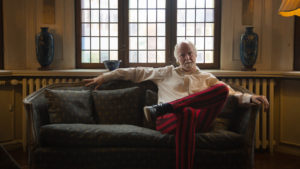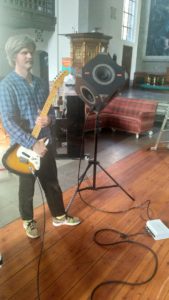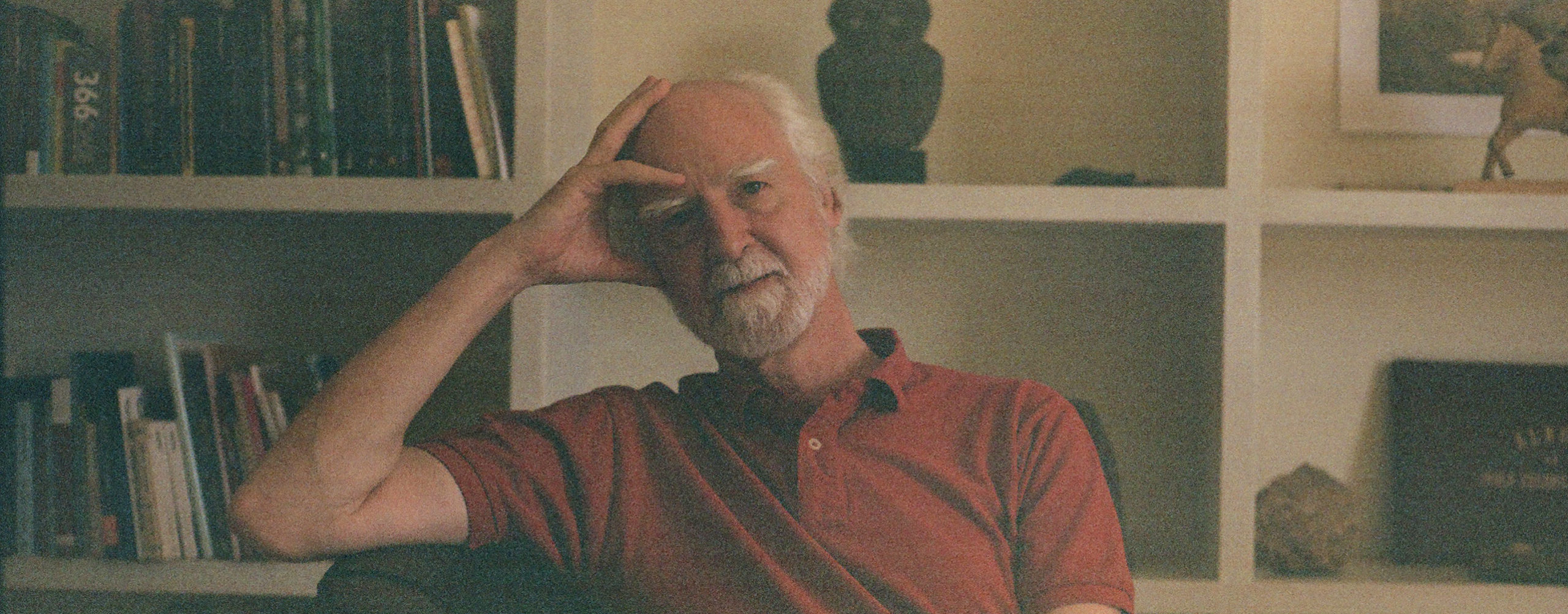Lars Graugaard (aka Lars from Mars) is a Danish musician, composer and performer with a long and celebrated career in electronic music. At 63, his focus is on his latest creation: an algorithmic system that aims to generate an immersive sound experience.
Sitting in the spacious living room of Lars’ apartment in Santa Lucia, Santiago, Lars welcomes us to talk about music and other projects that he had mentioned to us some time ago, and that we have been lucky enough to see evolve. One of them is the Sound Object, a technological creation which uses a unique algorithm that tries to change the way we listen live.
This system seeks to generate an immersive sound experience by decomposing sound into 20 to 30 different elements, emitting them separately and then recombining them in the acoustic space through a speaker with three aerial points.

To understand how it works, Lars proposes an exercise: “It’s easier if we give an example. If you imagine an acoustic guitar, the sound comes from the string itself, but it is reproduced through the box, and the box has a surface that emits the sound, which is what makes the resonance. The algorithm has to do with frequency ranges, it’s like an equalizer that works in ranges, so I separate in many batches; up to 29 individual ranges per channel.”
This technology allows the sound to be perceived in a more natural and immersive way, creating an auditive experience that feels like having the band playing live with you. Lars discovered this by chance five years ago, when he noticed the difference between the experience of listening to a recording through a traditional sound system and experiencing live sound in the environment. The fact that Sound Object does not use a switch box to separate the sound into left and right results in a shadowless listening experience, which has, unsuccessfully, been searched for for a long time.
To achieve this, Sound Object produces a three-dimensional monophonic sound, which expands spherically, allowing the sound it emits to blend with the ambient acoustic profile, giving it its characteristic naturalness. The technology features a single device that can emit both left and right sounds separately, and the use of two devices can create an even more immersive sound experience.
The biggest challenge with Lars’ creation is getting people to understand its potential. “If I want to get someone to invest on the project, I need to make them understand what this is all about and its potential. It is attractive, when I explain it, but it’s also complex,” he says.
“When working with sound, we are still handling a concept that was invented in the 30s, it is a very old system and has already passed its point of maturity … all sound companies have tried to improve it, but without changing the basic system, they continue to have the same basic problem. Nowadays this system is not appropriate, because people have other listening habits, and do not respect the stereo format. That’s why the Sound Object has a lot of potential.”

After having made about eight or ten presentations to large companies, Lars tells us that the Sound Object generates intrigue and rejection at the same time. Intrigue because of the progress and the possibilities presented by this technology, and rejection because of the simplicity of the proposal, that compared to the complexity and sophistication of the sound systems of these companies, is a direct and novel solution. However, this has not been an obstacle for him. Lars knows that his invention is more attractive to new companies, which are not so big yet, but with ambitions to enter the market, they need elements to differentiate from the competition. So he is putting his plan in place to offer different types of products and show what they are capable of.
“What I use is nothing unknown, but it’s a new way of doing things.”
When asked about the process of discovering the algorithm, Lars tells us that it was a coincidence. “Since 2010 I have been working at NYU with artists and one day I saw that they had a set of speakers stored in different clusters. They told me their idea; which was to make a kind of ambient sound, Ambisonics, but again using the same stereo thinking. So I started to create complex sound waves through simple independent waves, so that they would build up in the environment, and testing it, I saw that the difference was huge. It had to do with the sensuality of the sound…“
 After this first idea, Lars worked with an instrumentalist to separate the sound wave of his instrument
After this first idea, Lars worked with an instrumentalist to separate the sound wave of his instrument
into many simple elements to output separately. “I came up with it one afternoon in a moment of desperation before a duo gig, trying to find a way to place the other musician in my system, but since then I’ve worked a lot to polish it. Now it works absolutely instantly with live music or streaming etc, you don’t notice it.” Lars relates.
“In my invention I have no problem with space, on the contrary, space is my friend, in the guitar analogy, the algorithm is the string, but the environment is the sound box.“
“To make the Sound Object fully functional and adapted to its context, you have to know how to separate the sound. It’s different in the case of being used in a restaurant, or in a room, for example. Then, prototypes are made and tested with musicians to then make a demonstration. All this is done step by step, so that our providers can understand it and produce. Finally, it has to be discussed with distributors, in order to reach the public, who do not buy something they do not know.”
When asked about the stage of the process he is currently in with Sound Object, Lars shares with us that he is halfway through, with prototypes that are already working. His goal is to have the first production in stores in the first half of 2024, but he also assures that he needs to have a well-defined plan before looking for investors.
The devices are already in Denmark, with musicians making acoustic prototypes, including high quality, transportable speakers for studios. While not cheap, Lars has conducted successful tests and already has several testimonials, performing concerts with the system so that audiences not only have to take his word for it, but also the experience of other musicians.
Although it does not yet have an official name, Lars assures that he is working on it and will decide when it is launched. He feels that the tentative name “Cube Sound Object” is not suitable for the algorithm, so he is looking for more appropriate options.
Inquiring about how his invention could help electronic musicians, Lars explains how his system is an advantage: “The interesting thing is that it’s a speaker-borne acoustic sound. When DJs and producers work with electronic music everything is synthetic, but when you get to the last stage, electronic music includes an extra division and has an impact on how it sounds. It’s true to the source of the music itself, but with added space.“
His system allows you to avoid the stereo problem and is also multidimensional, meaning that if you listen to a violin, for example, the sound wave pattern changes according to pitch, and you can feel the movement of the tones. Lars’ technology is also dynamic, which contributes to an even more realistic and complete experience.
This project is certainly a breakthrough in the way we listen to and experience music, and we’re excited to see what the future holds.

